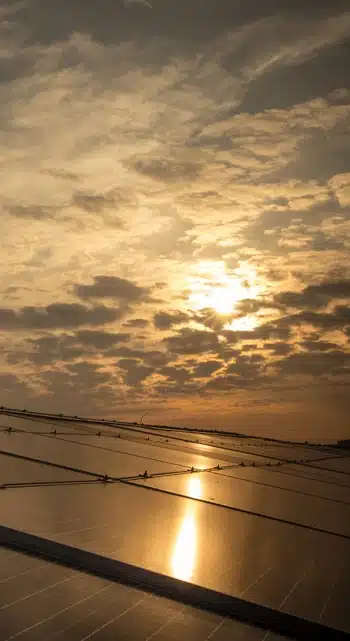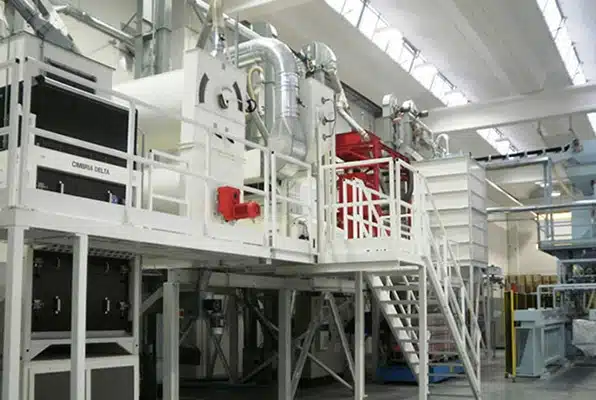India has long been an agriculture-focused nation. The agricultural sector of the nation provides roughly 16.38% of the country’s GDP. In a nation where agriculture is the main sector, improving production efficiency and using minimum wages to boost productivity must be the top priorities. Statistically, it is estimated that the quality of seed alone contributes to 15-20% depending upon the crop.
The first and most important step toward national food security is the establishment of a strong seed system, which also serves as a catalyst for agricultural expansion. The Indian seed business has steadily developed from a mostly governmental sector in the 1960s to a multifaceted industry with the participation of many private enterprises and increased focus on research and development operations.
Seed processing means, improving the quality of harvested seed including several operations starting from harvesting of seed crop till marketing. Seed processing assures the end users, that seeds are of high quality with minimum adulteration.
As the Indian population is set to be the world’s highest by the year 2027, the importance of this industry has increased exponentially.
Food demand is altering as a result of the decade-long trend toward urban life. In India, the average annual increase in food consumption per person is 4%. As a result, the per capita consumption increased from Rs. 9,360 to Rs. 15,390. At the basic level, India must enhance the seed-processing levels and units with a consistent supply of high-quality seeds at a cheaper price in order to boost the value of agricultural production by 130%.
The sector has, however, consistently been constrained by an unstable power supply and poor seed processing standards. For the majority of crops, India now only produces between 50 and 60% of its maximum yield.

Components & Working Process of Seed Processing Plants:
In general to improve the seed quality through the removal of adulterants, non-seed material and broken seeds.
The main objectives of seed processing are:
- To maintain seed viability and vigour,
- To make seed handling easy,
- Increase the real value of seeds

There are several methods used for seed processing:
- Seed Drying: Here, the moisture content of the seed is lowered to a secure level. Due to a decrease in moisture content, the seeds survive much longer. The chance of insect and pest attacks rises with rising moisture content due to increased respiratory activity, which also lowers seed quality.
The two main drying methods are natural drying and artificial drying:
The seed that has been threshed could or might not be dry enough to be stored safely depending on the environment and harvesting technique used. The threshed seed needs more drying when the weather is less ideal.
There are two stages of moisture elimination:
- The seed’s surface wetness was originally lost to the drying air.
- The loss of moisture from the surface leads to an imbalance in the moisture potential between the seed’s surface and inner partition, which encourages moisture to migrate from the inner organ to the outside layer.
The environment around the seed’s relative humidity and temperature affect how much moisture is removed from it.
Drying Temperature:

- Natural Drying: This is the most popular and traditional way of drying seeds, in which the sun’s radiant energy is used to dry the harvested crop on the ground or threshing floor. A seed needs around 2-4 days of direct sunshine to dry out to a moisture content of 10–12%.
Mechanical Drying / Artificial Drying:
- Forced Air Drying: This technique involves blowing heated air or natural air across a seed layer until drying is complete. Typically, forced hot air drying is used in seed godowns. For unrestricted air circulation, two kinds of ventilators are often placed. The area’s heated air is circulated with the aid of an electric blower.
- Continuous Flow Dryers: The seed is moved horizontally or vertically through a stream of hot air in this kind of dryer before entering a chilling device. However, when a cultivar change occurs, these dryers are difficult to clean. Because the seed is heated for a much less period, these dryers are able to employ air temperatures that are greater than those of a batch of dried goods.
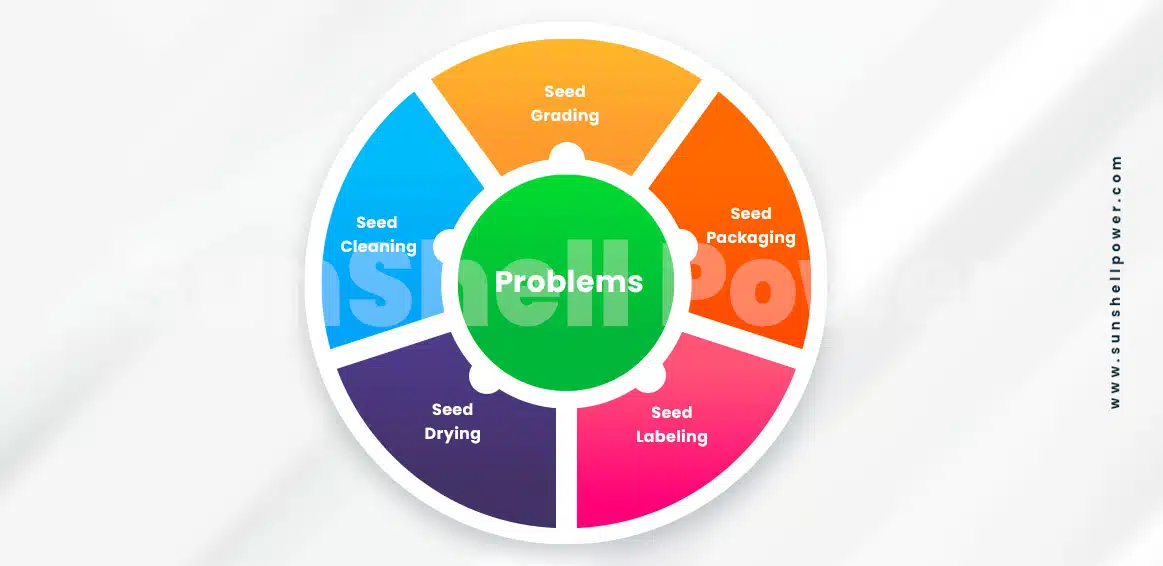
- Seed Cleaning: Cleaning seeds involves removing dust, dirt, any seeds with poor equality, contaminated or infected seeds, and seeds from alien species. Maintaining an accession is expensive. Damaged seeds and debris may transmit illness and shorten the survival of other seeds.
There are four main techniques for cleaning a seed collection:
- Separating seeds from bulk material and smaller trash may be done by using sleeves with varying mesh sizes and, if required, a rubber bung.
- Use a seed aspirator to remove debris or empty seeds that are the same size but lighter or heavier.
- The most gentle and effective way to remove pappus is using a rubber mat and finger massage.
- Debris and trash are removed piece by piece during hand-sorting.
Seeds need to be cleaned as soon as they are registered or harvested.
Air Screen Cleaner: This is the most important machine in every cleaning plant. It uses screens and aspiration (air blow) for two separations. A coarse upper screen removes larger material, a lower fine screen stops the seeds and lets through fine matter and then the seed fraction passes through a transverse or nearly vertical air stream which can separate light impurities such as empty or partly filled seeds, husks and glumes from the seed. In most case a number of sieves with different sized perforations are used and cleaning is a process of gradually shifting out smaller particles. Factors which determine the quality and speed of movement of the sieves and correct cleaning and mainteance of the equipment.
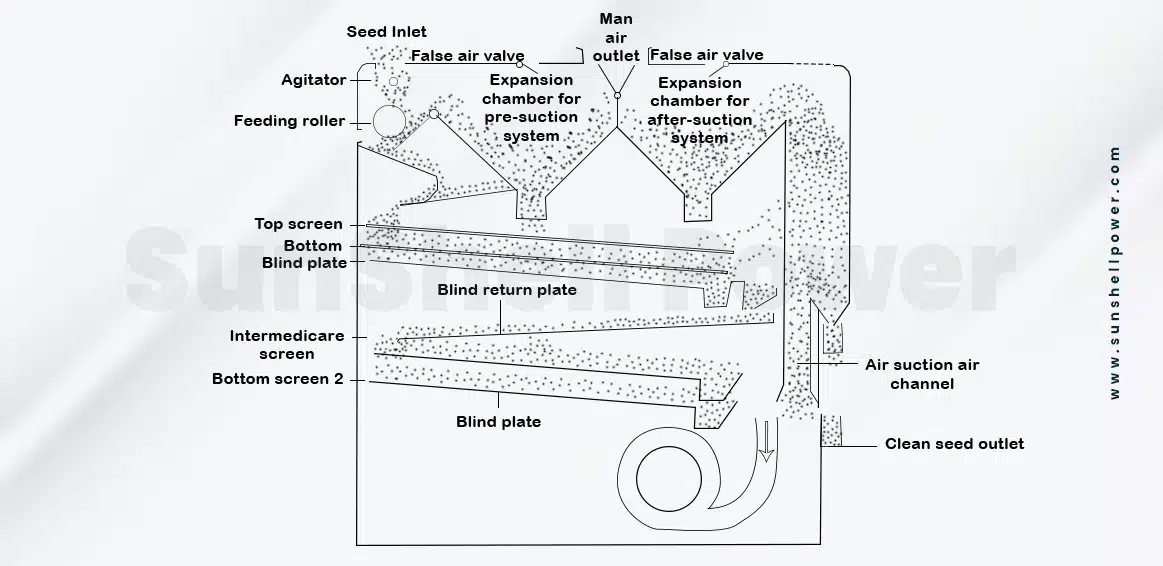
Seed Grading: The quality, appearance, and viability of the collected seed are influenced by a number of variables. To increase sowing seed quality, these factors—such as inert matter, other crop seed, immature seed, damaged seed, infected seed, weed seed, and undersized seed—must be decreased up to a threshold level. The grader uses a screen with a varied mesh size and vibration to remove coarse contaminants and undersized seeds from the usually acceptable seed based on seed density and size.
Grading is the process of grouping a seed lot according to its commercial applications, such as size, shape, density, colour, etc. Different separator kinds are needed during grading to get rid of weeds, broken seeds, and undesired seeds. The following are the many kinds of grading equipment:
- Disk Separator: The disc separators may separate fragments of broken seeds, weeds, and other agricultural seeds with a circular form. It contains a number of recessed discs that revolve within a cylinder as the seeds flow through them.
- Indented Cylindrical Separators: It can separate the impurities especially broken seeds, other crop seeds and weed seeds that are either longer or shorter than the crop seed. It has two types of grading systems forwarding grading-removal of impurities of shorter than the required seed size eg. Wheat, rice Reverse grading-removal of impurities larger than the required seed size.
- Gravity Separators: The variations in density between acceptable seed and unwanted seed were taken advantage of by gravity separators. The seeds are vertically layered on the deck according to their density by vibration, using the flotation principle. Removing immature, damaged, and unattractive seeds increases the germination percentage of the seed lot.
- Spiral Separators: The spiral or dropper separators make use of variations in the seed’s shape or roundness to remove contaminants.
Roll Mill or Dodder Mill: The rolling mill is used to separate the seeds based on surface texture and shape. This separator should be used only after the seed has been carefully cleaned, separated from the chaff and dried. These are effective in separating seeds with a rough seed coat or shape angles from smooth seeds.
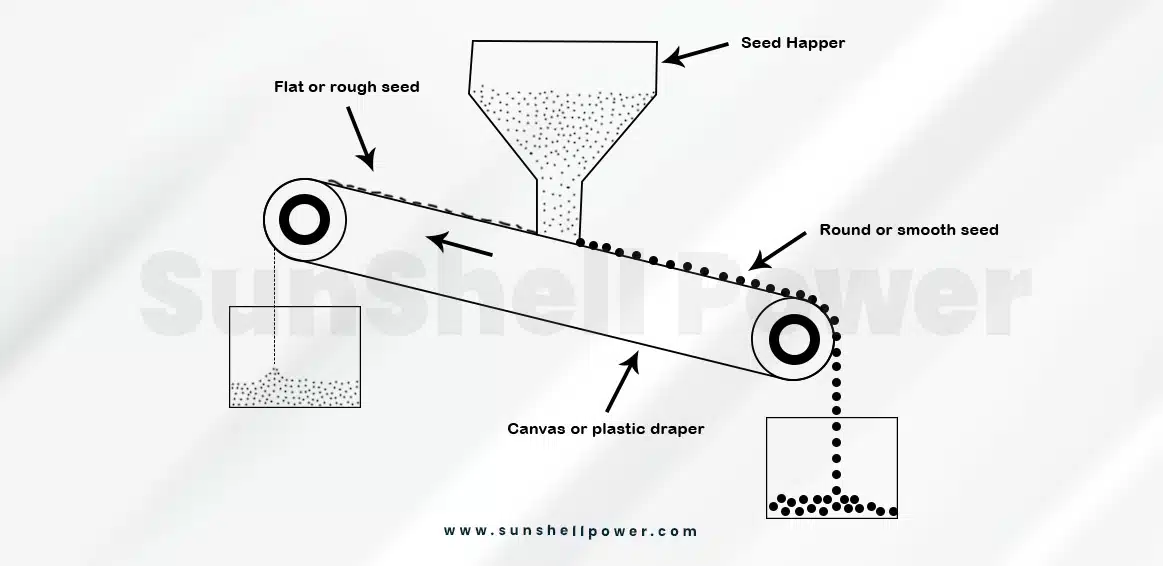
Seed Packaging:
The seeds are put in containers with a certain new weight after being processed and treated. When seeds are dried, packing protects them from insects and illnesses, prevents them from collecting moisture from the air, and keeps each accession distinct. For storing seeds, a variety of containers and specialized sealing tools are available. Base collections should be stored in hermetically sealed, moisture-proof containers. There are many seed packing and bagging techniques:
- Bagger-weigher: These are little devices that, when positioned correctly underneath a bin, can precisely fill and weigh a bag in one step.
- Manual Weighing: The high labour requirements and relatively limited capacity, measured in the number of bags filled per minute, of this kind of scale—typically a movable platform—make it unsuitable for bulk weighing operations. This scale requires that bags be roughly weighed before being loaded onto it and ‘even weighted’ using a hand scoop. These scales are helpful in the following circumstances:Weighing bags of non-free-flowing seeds,
A bagging bin is not available,
Labour costs are minimal. - Seed Labeling: After the entire processing is completed, the seeds are packaged based on their quality, genre and other attributes.
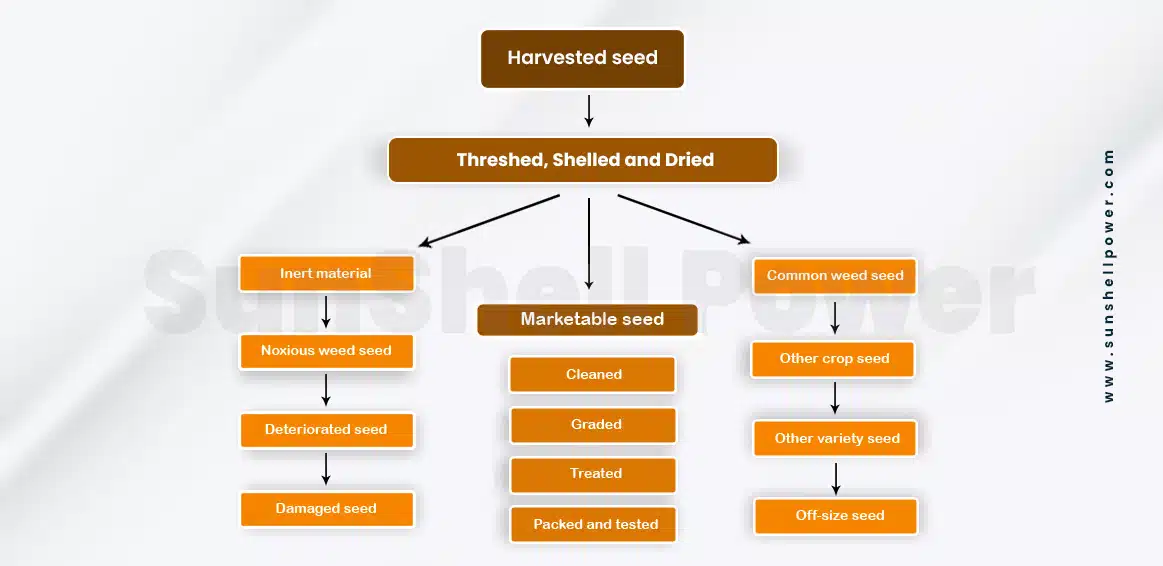
Electrical Load:
The kind of seeds used and the plant’s daily operation hours affect a seed processing unit’s power usage. According to statistics, each tonne of wheat, rice, or maize required 32.8, 50.6, or 87.3 units of electrical energy. The processing machines used in seed processing plants are hereby:
- Ensco-super- 300 kg/hr
- Cripen Model- 250-300 kg/hr
- Junior Petkus- 500 kg/hr
- Giant Petkus- 1000-1200 kg/hr
- Tucas- 300kg/hr
The electrical load of a seed processing plant solely depends on the type of seed processed in the plant during a period and the production quantity. Generally, a seed processing plant, having an annual capacity of 10,500 quintals of seeds, requires a connected load of approximately 150 kW.
Problems faced by Seed Processing Plants:
Seed processing is a lengthy and time-consuming process, requiring a substantial electrical load during its entire day of operation. Due to high electricity demand, unreliable power, and an ever-growing demand for healthy seeds in India, the whole sector is facing the following problems:
- Frequent Power Failure: Seed processing is a power-consuming process and requires a constant supply of reliable power. In most of cases, seed plants are located in remote locations, close to the farming fields where reliable power is an issue. Sudden voltage drops or power cuts cause the entire process to a halt. Especially in the seed drying process, the moisture level of the seeds increases making them vulnerable to bacteria and the lifetime of the seeds decreases at a rapid rate, producing low-quality seeds.
- Lack of Effective Monitoring Mechanism: The manufacturing process lacks an efficient monitoring system for maintaining the quality of seeds. Voltage fluctuations and frequent power outages create risks throughout the manufacturing process, resulting in erratic seed quality. The market is being flooded by a lack of monitoring mechanisms, not only throughout the production process but also at the selling point. Even seeds whose samples failed SSC laboratory testing are sold by the vendors. This is mostly due to the inability and expense of monitoring the sale of seeds.
- Lack of Infrastructure: For farmers, obtaining seeds on time continues to be a challenge. Poor infrastructure in far-off villages, a lack of buying power at the time of sowing, and the unpredictability of rainfall, which is heavily reliant on the sowing, all contribute to the issue. In addition to procurement, the use of outdated equipment and procedures extends the production time.
- Unpredictability of Demand: Due to the unpredictable nature of nature, fluctuations in the pricing of commodities, and other factors, it is exceedingly difficult for dealers to precisely estimate the demand for certified seeds. Lack of infrastructure and lack of mobility in the manufacturing process causes the supply to lag behind the demand when the demand for seeds spikes suddenly.
- Usage of Diesel Generator: The bulk of seed-processing plants are found in sparsely populated rural regions. Because power outages occur so often, even when a facility is linked to the grid, the majority of seed processing plants rely on diesel generators as their main backup source. Utilizing an excessive number of diesel generators causes too much carbon emissions, further damaging our environment as daily fuel price increases.
Power Backup:
The majority of the seed processing plants use Diesel generators as their main backup energy source. These diesel generators have a capacity of around 800-1000 gallons.
So, What’s The Way Out? Solar Solutions for Seed Processing Plants!!
Human civilization is increasingly moving towards renewable energy as technology advances. Solar power plants are also the most dependable renewable energy source.
With ever-rising population growth, the need for power in the seed processing industry is higher than ever.
SunShell Power provides rooftop solar solutions for all seed processing plants. Solar modules have a 25- year life expectancy and need no maintenance, making the plant a stable power source.
For seed processing plants, we offer two types of solar solutions:
- Grid Connected Solar Rooftop Plant
- Solar Street Light
Grid-Connected Solar Rooftop Plant (On-Grid):
Grid-connected solar power plant with little maintenance and accessible net-metering capability, as well as a credit system based on power banking. This sort of power plant is excellent for establishments with high demand and infrequent power outages.
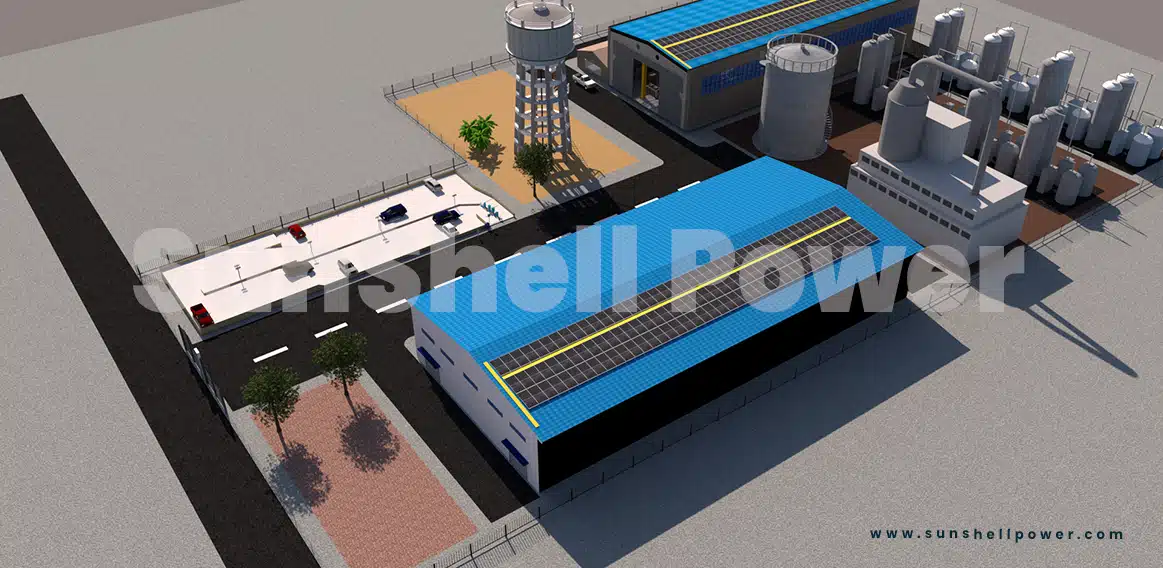
Why On-Grid?
Even though, in SunShell Power, every solar power plant is important and valuable for us, for seed processing plants we would highly suggest the authority install on-grid solar power plants. From our previous experiences, we have pointed out several points from which we have declared the Grid-connected plant to be a clear winner:
- These systems are ideally suited for very high power usage and for lowering energy expenditures,
- On-grid plants can be installed with or without net metering,
- On-grid systems are very cost-effective and easy to install,
- As there is no battery backup in the system, there are fewer chances of battery failure and hence the maintenance is minimal which can be helpful in the busy environment of the processing unit.
Benefits of Installing Solar:
Now, the question may arise to your mind- “Why should I invest in solar?”
Apart from being eco-friendly and producing green energy, solar power plants are a great financial and economical investment and also a reliable power source. Here, from the feedback of our previous consumers, we have listed 6 overall benefits of solar:
- Hedge against rising energy costs,
- Self-reliance,
- Green Commitment,
- Carbon Neutral,
- The government gives subsidies for solar panel installation.
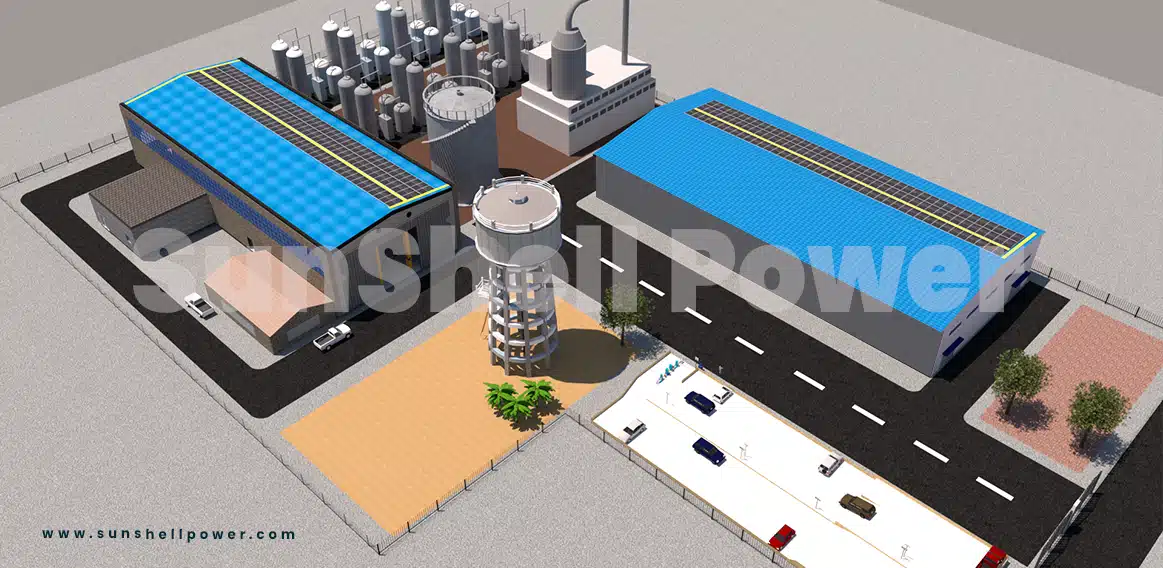
Average ROI:
The average payback of a grid-connected solar power plant in a seed processing plant is around 3.5-4.5 years, although it can change based on the electrical load of the rice mill.

Alternative Solutions:
- Solar Street Lights: As the compound area of a seed processing plant is huge and regular operations of transport vehicles are a common scenario here, proper illumination is an important subject. The majority of the rice mills have storage facilities where costly rice grains are supposed to be stored, where these solar lights can be used as safety equipment during the night-time.
- Two in One (Semi-integrated): Used for a variety of purposes, these are easy to install and are low-maintenance.
- Solar Mini Mast: Best for places with unstable power sources, uses green energy and needs almost maintenance.
Energy Auditing:
Energy auditing is an energy assessment. This assessment looks at how energy flows through a structure, process or system in order to minimize energy input while preserving or increasing human comfort, health, and safety. According to the definition of ISO 50002 standard, an energy audit is a systematic analysis of energy use and energy consumption within a defined energy audit scope, in order to identify, quantify and report on the opportunities for improved energy performance.
There are three types of energy audits:
- Grid Connected Solar Rooftop Plant
- Solar Street Light
- Investment Grade Audit
Depending on the purpose and potential savings the type of energy audit is chosen.
If the priority is to identify potential savings and further studies a walk-through audit is recommended whereas if the intention is to invest a large amount of money in energy efficiency measurement an Investment Grade Audit is done.
Benefits of Solar Solutions for Seed Processing Plants :
- Energy Auditing helps reduce costs in the facility,
- It helps reduce environmental damage and pollution,
- If any energy is active then it can be detected.
Become A part of The Green Future:
India has set a goal of having net-zero emissions by the year 2070 while the rest of the world makes plans to become carbon neutral. The government is providing a number of programmes and laws for solar installations; it is our responsibility to do our bit to help this green goal succeed.
In the food and seed processing industry, solar power plants have a huge potential and as there is a power demand in the country, the requirement for green energy is higher than ever. Even though there are some products for seed mill machinery, there is a huge potential for rooftop solar plants in those facilities.
A 364 kW grid-connected system was constructed at one of the largest seed processing factories in Nonthaburi, Thailand, to power its seed processing facilities, including the cold and dehumidified storage and generating rooms. More than 540 private seed enterprises with a market value of USD 63 billion in 2021 and a CAGR of 6.6% from 2021 to 2026 are present in the nation. By 2030, the Indian Central Government hopes to have installed 500 GW of renewable energy. Therefore, it is imperative that industry transition to solar power in order to make the earth greener by lowering its carbon impact.
Enquire Now
